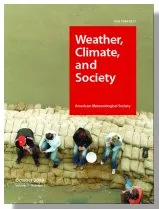- | Academic & Student Programs Academic & Student Programs
- | Journal Articles Journal Articles
- |
False Alarms, Tornado Warnings, and Tornado Casualties
Originally published in Weather, Culture, and Society
This paper extends prior research on the societal value of tornado warnings to the impact of false alarms. Intuition and theory suggest that false alarms will reduce the response to warnings, yet little evidence of a “false alarm effect” has been unearthed.

This paper extends prior research on the societal value of tornado warnings to the impact of false alarms. Intuition and theory suggest that false alarms will reduce the response to warnings, yet little evidence of a “false alarm effect” has been unearthed. This paper exploits differences in the false-alarm ratio across the United States to test for a false-alarm effect in a regression model of tornado casualties from 1986 to 2004. A statistically significant and large false-alarm effect is found: tornadoes that occur in an area with a higher false-alarm ratio kill and injure more people, everything else being constant. The effect is consistent across false-alarm ratios defined over different geographies and time intervals. A one-standard-deviation increase in the false-alarm ratio increases expected fatalities by between 12% and 29% and increases expected injuries by between 14% and 32%. The reduction in the national tornado false-alarm ratio over the period reduced fatalities by 4%–11% and injuries by 4%–13%. The casualty effects of false alarms and warning lead times are approximately equal in magnitude, suggesting that the National Weather Service could not reduce casualties by trading off a higher probability of detection for a higher false-alarm ratio, or vice versa.
read more
Find the article at the American Meteorological Society.

